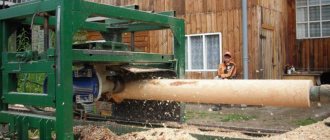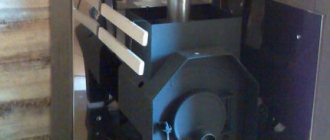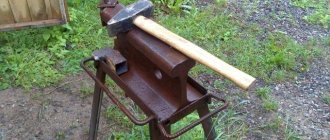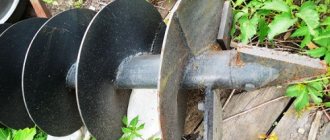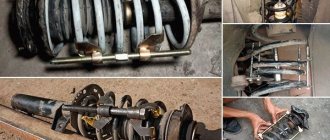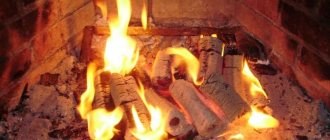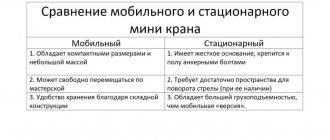The quality of any steam room is determined by the correctness of its layout and the organization of heating of the room. You can use a brick oven, a steel or cast iron firebox, or a gas burner, but all this is unsafe and not always convenient. Experts rightly believe that the best choice would be a specially designed electric sauna heater. A relatively simple device, there will be a minimum of problems with fire or carbon monoxide, and most importantly, it is relatively easy to make with your own hands.
Sauna heaters can have a very unusual design
How to make an electric oven
Who doesn’t want to have their own bathhouse or sauna at their dacha, where you can not only relax and relieve fatigue and tension, but also improve your body’s health.
First of all, having decided to build a steam room, you need to decide on the choice of a sauna stove. You can buy it or learn how to make an electric furnace yourself and do a fairly simple job of assembling it, thus saving significantly on it. When purchasing an electric sauna stove, focus your attention on the following factors:
1. Maintaining optimal temperature and humidity levels created by the oven.
2. Serviceability of the design and its efficiency.
3. Make sure that the stove will fit into the interior of the bathhouse.
Types of furnaces
1. The classic version of a sauna stove is a massive brick stove that heats water and heats stones. It is worth noting that this type has many disadvantages associated with the complexity of its operation. Brick structures are located on a special foundation. When using, you must carefully adhere to all safety precautions, conditions of its maintenance and maintenance. It is recommended not to do the laying of a brick stove yourself, but to call a specialist - a stove maker. The fuel source for this design is wood. The stove has a large heat capacity, it is heated for a long time, it is necessary to have ventilation holes and a chimney.
Do not forget that if you have a brick or metal stove in your house or bathhouse, then you should clean the chimney from time to time. You can find tips on how to quickly clean soot from a chimney in the article. An article on installing a sandwich chimney with your own hands may also be useful - one of the popular types of chimneys today.
2. Metal stove. This design is less bulky than brick. It is made of steel sheets, and the fuel is firewood. Such a stove weighs an order of magnitude less than a brick stove; there is no need to pour a special foundation for it, but it requires a pedestal that rises 20 cm above the floor.
3. Electric oven. Ideal for small baths or saunas. It takes up little space and is easy to use. There is no need to install a chimney.
The advantage of using an electric heater
There are a number of advantages of using an electric sauna stove. Everyone can get this entire list of advantages; you just need to understand how to make an electric oven with your own hands.
1. Such stoves provide rapid heating of the room, as well as maintaining the desired temperature throughout the entire period of operation.
2. A chimney, as we said earlier, is not required. Since fuel is not used, the combustion of which produces ash, the cleanliness of the bathhouse is maintained. The need for a separate ventilation system also disappears.
3. The stove does not require complex maintenance, as is the case with a stone structure. In addition, it does not need to be cleaned of soot, unburnt fuel residues and soot. To heat a room, you simply need to provide electricity, turn on the heating and specify the desired temperature.
4. Operating an electric furnace is quite simple. The temperature regulator is located directly in the steam room. A constant temperature is maintained throughout the entire time the electric furnace is used, and overheating is simply impossible thanks to the fuse.
5. Operational safety. There is no release of carbon monoxide (carbon monoxide), so poisoning with it becomes impossible. In addition, due to the fact that there is no open fire, there is no chance of wooden objects catching fire.
If you have not yet built a bathhouse or sauna, then we recommend that you familiarize yourself with the possibility of placing a sauna in the basement of the house. The article describes in detail the rules for ensuring proper air exchange, design and other nuances that should be observed when building a sauna in the basement.
6. Since the stove is small in size and weighs little, it can be installed wherever it is convenient for you. It makes no sense to install a special foundation in advance; all you need is a compact pedestal. Sometimes there is a need to build a brick partition, which performs a protective function and ensures safe rest.
The video below describes in detail the types of electric furnaces, their advantages and disadvantages.
How to make an electric oven yourself
First, you need to decide on the type of electric sauna stove that you will install, and then proceed to its assembly. Typically, such designs are used when soft, dry air is needed in saunas.
Electric sauna stoves are impossible without tubular electric heaters (TEH), regardless of whether the stove is a closed or open type. Typically, the design of the furnace is very simple: a metal body, inside of which there are tubular electric heaters, and a cage filled with stones should be installed on top.
In a furnace with a closed body, the components are a heating element, a heat shield and a conductive busbar. The open design is characterized by the presence of nichrome wire located in a ceramic stand.
It is recommended to use a three-phase network with an input voltage of 380V, but if the dimensions of the bathhouse are small, you can use a single-phase network (voltage is 220V). A stove operating on a single-phase network produces 3 kW.
Be careful. An electric furnace in a metal casing must be grounded. When first turned on and used, you need to measure the resistance. The norm is no more than 5 ohms.
About the future design
Construction of a homemade electric stove for a sauna
The simplest model of an electric stove consists of a box-shaped body, inside of which there is a tank with a door on the neck for adding water and several heating elements welded together. Stones are laid on top and between them. When heated, the stones release thermal energy into the steam room, raising the temperature in it to the optimal level.
For metal structural elements, stainless steel is used, which does not corrode in water, does not burn out under high temperatures and does not emit harmful substances.
If possible, the device is controlled by an electronic remote control, which should be located outside the steam room. It is connected to the furnace heating unit with an electric cable.
The heating system is activated by turning on the timer. The maximum permissible heating level for heating elements is 650ºС. If the temperature drops to 600ºC, the sensor is triggered and the “Heating” light comes on. The stones are heated when the timer is in standby mode.
As soon as the top layer of stones heats up to 550ºC, the timer is triggered and the light turns on in the “Ready” position.
Stones can also be placed on top of the body above the heating elements on a metal grid welded from reinforcement and during bath procedures, water them or herb infusion to create steam.
Electric heater assembly
We know how to make a quality electric oven with our own hands. It is necessary to follow a certain technology:
1. We draw up graphic images of the future design, determine the dimensions of the room, which will determine the size of the furnace, location, and required power. Standard electric furnaces do not have large dimensions; they are very compact.
2. We calculate the number of heating elements. Their number will depend on the required power of the furnace, its dimensions, as well as the power of one electric heater used.
Diagram of an electric heater with heating elements
3. We assemble the electric heater itself. The heating elements are fixed to the frame and connected using jumpers. A pre-prepared steel sheet with a thickness of about 3 mm is fastened with bolts or welding.
4. We lay the stone filler tightly so that the stones are located tightly, without cracks or gaps.
5. Install the protective casing. It can be made of the same material as the base for the stove - sheet steel. You can also install a brick wall that performs the same protective function.
6. The electric furnace should be connected using parallel and series connections of heating elements. A necessary design element is a thermostat, using which you will regulate the heating of the stones. The use of drum or rotary switches is recommended.
7. The final stage is checking the serviceability of the furnace, operational safety and ability to perform all specified functions.
Obviously, today it is appropriate to use electric stoves for baths or saunas that do not have a large area. A massive brick stove is too bulky for small spaces. In addition, stoves that use wood fuel require too much maintenance. Since the cost of electrical structures is quite high, you can save a lot by making an electric furnace yourself.
Manufacturing instructions
Making an electric stove for an indoor sauna with your own hands consists of the following steps:
- Development of a detailed drawing on paper with determination of the optimal dimensions, power required for heating, and location of the future device. Typically, the body of an electric furnace is made to be small in volume; the main space in their design is occupied by a basket for stone backfill. The body shape can be any, but a rectangular oven will be more convenient for operation. It is more stable and can maintain its shape for a long period of time. Due to the fact that its corner zones almost never become hot, a balance of heat flows and uniform heating of the room are maintained.
Calculation of the number of heating elements for the furnace, based on the power of one element.
Marking body parts on a steel sheet and cutting off the required parts.
Connecting heating elements into one structure using metal strips.
Fastening the heating elements on one of the sides. They are mounted to one of the sides of the furnace - side or bottom, using bolts or welding. The distance from the heating elements to the metal walls of the housing must be such that a sheet of asbestos can fit into this gap. Its heat transfer coefficient is minimal, so no heating of the housing directly by the heating elements will occur.
Furnace body assemblies. Sheet steel parts are fastened by welding or bolts.
Welding reinforcement legs from the bottom of the furnace body for installation on the floor.
Laying stones in dense layers, without gaps or large cracks. Larger stones are placed at the bottom, and then smaller fractions. There should be a small gap between the heating elements and the filler for air convection; the last row of it should completely cover the heating element, but not be higher than 8 cm. When laying stones, the heating elements must be held.
Making a protective casing for the furnace from sheet steel or fireclay bricks.
Installation of power tools in the oven. For this stove, a simple circuit diagram is taken as a basis: voltage from the network is supplied to the terminals of the remote control controller, and the wires coming from the heating apparatus are connected to the output terminals.
Installation of the furnace control panel. The steam room maintains a high level of temperature and humidity, so the remote control should be installed on the wall in another room, where the temperature is not higher than 25 - 28 degrees. The wires from the control panel must be connected to a separate circuit breaker in the electrical panel and laid in protective corrugated sleeves. Previously, special grooves are punched in the walls for wiring, which, after installing the wires, are sealed with non-flammable building materials, for example, a cement-sand mixture.
Installation of temperature and humidity control sensors for an electric oven. To connect them, heat-resistant cables are used, one-piece in length, without joints. Usually they are mounted on top of the unit, above the shelves or above the entrance door to the steam room.
Ground loop devices. The electric stove must be connected to the line of its own grounding loop, which is recommended to be laid in the ground during the construction of the sauna. It is connected to the furnace using protective cable channels. If you didn’t worry about grounding at the time, then the grounding cable of the stove must be connected to the neutral terminal of the electrical panel.
Installation of a thermostat. It is installed inside the structure and is used to measure and adjust the heating temperature of the stones.
Improvement of the appearance of the stove. The body parts are cleaned with sandpaper, degreased with gasoline or acetone, primed and painted with two layers of heat-resistant paint;
Checking the operation of the oven, installation safety and connection.
Why choose electrician?
Nowadays, it’s really easier to build an electric heater than to heat a stove with wood. Because it:
- Clean - no ash on the floor near the firebox and ash pan; there is also no need to get your hands dirty to light the fireplace;
- Quickly – start and heat up the oven, this process does not take much time;
- Safe - the likelihood of getting burned is minimized. There is also no risk of gas leakage or explosion, and the likelihood of a fire is significantly reduced;
- Convenient - using a modern control panel, setting any specified parameters is not difficult;
What’s true is that you’ll only have to put up with high energy costs, so if you’re ready for them, let’s move on.
What is needed to manually assemble a stove?
If you are planning to create an electric stove for a bathhouse with your own hands , you need to select a thermal heating element (TEN). It is also worth deciding what type of oven will be, open or closed. Usually the second option is chosen more often, since the heating element in it can be installed in any position. In addition to the heater, you will need a screen and a busbar for the voltage wire.
Advice: it is recommended to connect stoves to a three-phase 380V network in order to heat the maximum area. For small steam rooms you can get by with 220V.
Electric heater assembly
When starting to work with electricity, it is necessary to familiarize yourself in detail with construction and technical instructions, check the equipment and use a protective suit. When assembling an electric sauna stove with your own hands, be sure to maintain grounding, and also check the resistance when starting it for the first time so that it falls within the range of 3-5 ohms.
What the body is made of and what size it should be is up to you to decide, based on the volume of the room that needs to be heated. Sheet steel is usually chosen; the heater can be made with an open lattice or closed. Installation of equipment from pre-purchased or welded elements occurs as follows:
- First, the number of heating elements is determined based on the cubic capacity of the bathhouse;
- The heating elements are connected to each other using a system of jumpers;
- A heat shield is constructed from sheet steel;
- The heater is welded and laid out.
Advice: it is better to choose river stones, flat ones - they are sold ready-made in construction stores.
- The frame is assembled from metal sheets. The electric oven can also be lined with bricks.
- An electrical circuit is assembled in series and a control relay is installed. Rotary switches are usually chosen.
That's it, you can connect the oven to the network and after checking all the indicators, enjoy your new quick heating steam room.
Decorating an electric fireplace
You can decorate the portal of a false fireplace with stucco molding, which is fixed with glue. If the frame and cladding are strong enough, real plaster decor is used. It is better not to overload the plasterboard structure - use a lightweight imitation of polyurethane stucco.
You can hang torch-shaped lamps on the wall on both sides of the portal.
Another trick from the same opera is to install a woodpile next to the fireplace. It is a box, quite high, but shallow - the bottom is cut in almost at the very top. Several real logs or dummies made of plastic or ceramic (sold in stores) are placed on it.
The surroundings in the form of a woodpile make the false fireplace more realistic
You can make a rather naturalistic dummy yourself using corrugated cardboard as a material. Here's how it's done:
- Parts are cut out of cardboard, which are then rolled into cylinders of various lengths and diameters. Larger cylinders will act as logs, while smaller cylinders will act as knots.
- Using wide tape and glue, we attach the “knots” to the “logs”.
You can make logs from corrugated cardboard that are very similar to real ones. - The finished dummies need to be painted and placed in a woodpile.
To make cardboard firewood look realistic, you need to paint it
Do-it-yourself electric sauna stove
Content
If you have a country house, then there must be a bathhouse there. Perhaps it is already there. But whether there is a stove there is a question. Today there is a choice: buy a ready-made electric stove for a bath, or make it yourself. The second option will save money on purchasing a factory version.
If, after all, it was decided to buy a sauna stove in a store, then experts recommend paying attention to the following details of the future purchase.
- The level of humidity and temperature that will be obtained from the operation of the furnace.
- Cost-effectiveness and feasibility of the device.
- Pay attention to how the sauna stove fits into the interior.
About stoves in the bathhouse
Sauna stoves have become very popular due to the fact that they heat up very quickly. For stoves there is no need to build a chimney or remove soot. In addition, sauna stoves have a number of other advantages that are impossible not to list:
- maximum convenient operation of the unit. There is a control panel that allows you to adjust the necessary modes. You can even set the oven to turn off after a while
- a thermostat is used to protect the oven from overheating,
- maximum oven safety due to the absence of carbon monoxide,
- The oven body is not large. It is impossible to get burned by it.
As with any other thing, an electric sauna stove has its drawbacks. First of all, these are the excessive costs of electricity that goes into operating the furnace.
DIY sauna oven
Before you begin installing the stove, you need to decide what type of home-made device will have. Only then can you start working. Homemade stoves are used in baths where it is necessary to obtain dry air.
The most important element of the furnace is the heating element. It doesn’t matter what it will be: closed or open.
The oven, which is closed, can be installed vertically or horizontally. The DIY oven design includes a current-conducting bus, a heating element and a reflective screen. In order to make an open type oven, you need to use nichrome wire. It should be placed in a ceramic tube in the form of a spiral.
It is best to connect a three-phase network for the stove. Its voltage should be 380 volts. But if the oven is small, then 220 volts will be quite enough. The maximum power of the furnace, which operates on one phase, is 3 kilowatts.
In any case, the metal body of the furnace must be grounded. And when you turn it on for the first time, you need to measure the resistance. It should be about 5 ohms.
The sauna stove is assembled with your own hands. There are several stages of assembly:
- The oven is determined based on the room area and dimensions,
- Based on the power of the equipment, the number of heating elements is selected,
- jumpers are connected,
- steel sheets are attached to the sides with screws or welding,
- the stones are stacked as closely as possible to each other,
- the next step is installation of the protective casing. It is made from sheets of metal or brick,
- We connect the device to the network with our own hands.
Now, having received the necessary information, everyone will be able to install an electric furnace in the bathhouse with their own hands. There is nothing complicated about it. The advantages and disadvantages are described, so it’s up to you to choose. It is important to note that currently most saunas and baths use electric stoves due to their simple installation. However, recently, energy costs have made people think.
To install an electric stove in a bathhouse, you must have a certain set of tools that will allow you to complete the job efficiently and quickly. However, before installation it is necessary to consult with specialists who have experience in such work. You need to pay special attention to the electricity that you will have to work with when installing an electric furnace. After all, the lives of the people who will use the bathhouse depend on it.
It is not recommended to buy electric sauna stoves from unverified sellers. Otherwise, you risk becoming a victim of counterfeiting. It is unlikely that you will get your money back unless, of course, a guarantee was issued. Therefore, it is recommended to take out a warranty when purchasing equipment.
Additional recommendations for the master
But here all calculations must be made especially carefully in order to avoid excessive heating of the heating elements and their premature failure. Care must be taken when installing heating elements into a single electrical circuit. You definitely can’t do without some knowledge of electromechanics and electrical engineering. And if you don’t have such knowledge, then seek help from an experienced master.
Sometimes combined types of heaters are used in the interior of steam rooms. In addition to the electric stove, users install a brick wall finished with natural stone. This will increase heat transfer slightly, but additional safety measures will be required. You will need to lay a layer of thermal insulation between the load-bearing and imitation wall
This is important if the bathhouse is built using a large number of wooden elements (log house). For brick baths, there is no need for additional walls, since they only increase the percentage of heat losses
Do-it-yourself electric sauna heater
Despite the fact that many sauna lovers remain devoted to traditional stoves, the electric heater is a practical and effective device for saunas in yards, electric analogues of stoves are becoming more and more popular every day. You can either buy a so-called heater or build it yourself, and in both cases it will work much more efficiently and heat the sauna faster. Among other things, an electric heater is more comfortable than a conventional stove, and its installation does not cause difficulties. What types of heaters are there and how to connect a sauna stove yourself?
Dimensions
The smaller the sauna, the more important the size of the stove becomes. Low-power heaters are usually very modest in size. An example is the Harvia Compact stove - its width is 24.5-30 cm, depth 22 cm, height 54 cm. It weighs only 9 kg (without stones). Another model from the same company - Vega Compact - weighs even less: 7 kg and has dimensions: 28x29.5x50.5 cm.
IMPORTANT! Information on sizes is essential for selection, therefore it is always indicated in catalogs.
Yes, and one more interesting point: ovens of the same size (within the same line) can have different power. This allows the manufacturer to reduce production costs, and the consumer to choose a standard-sized heater for the volume of the steam room.
Further information will be useful to those who have already purchased a stove and need information on how to properly install and connect it.
Advantages of electric sauna stoves 220 volts
Despite the fact that electric furnaces have a number of their own features that should be taken into account during operation, they remain more convenient. Basically, heaters are installed in small baths and perhaps this is the only drawback of an electric stove. A wood-burning stove can be installed in a bathhouse of any size, but if we are talking about a home sauna, then a heater will certainly be the best option.
Electric furnaces have a long service life and attractive appearance
So, what are the advantages of an electric heater operating on a regular 220 volt network:
- Ease of use. All you need to do is buy the device from the store or equip it yourself - to turn it on, you just need to connect the oven to an outlet.
- Heating rate. An electric heater heats a sauna much faster than a wood-burning stove. You don’t have to languish in anticipation - plug in the oven and very soon you’ll find yourself in a pleasant, park-like room.
- No burning or smoke. No unpleasant smell, no soot. You just enjoy the process.
- No firewood needed. This is also a significant plus. You don't need to worry about fuel, just turn on the desired mode and the automation will do everything itself.
- Possibility of adjustment. The way the heater works is such that the boiler can be turned in the right direction if necessary. Heating elements are especially convenient in this regard. If the heat is too strong, simply reduce the heating power. Everything is extremely simple.
Specifications
All electric sauna stoves have the following parameters:
- Power. Being the main characteristic of any stove, power directly affects the heating of the sauna. To calculate this indicator, you need to start from the area of the steam room. To warm up one cubic meter of room, about 1-1.5 kW of power is required. If the walls of the building are thin and the thermal insulation is not of sufficient quality, the power of the electric heater should be increased.
- Volume. The degree of heating of the room and the amount of steam depends on the number of stones. In small steam rooms, stoves designed for 2.5 kg of stones can be used. For large rooms where long-term steam procedures will be carried out, it is worth choosing an electric heater designed for at least 6.5 kg of stones.
- Availability of a steam generator. Some models of sauna stoves have a built-in steam generator that produces wet steam, often used in sauna procedures. However, this point is far from the most important - if necessary, purchase a separate electric steam room that operates independently of the stove.
Features of an electric sauna stove 380 volts
If a conventional stove is not enough for you, then to heat a large room you can use a powerful heater that requires 380 volts to operate. Such a three-phase stove can heat up even a huge sauna for several groups of people in a matter of minutes.
The only disadvantage of this type of stove is that they require increased voltage in the network.
The canning oven can be of different types, regardless of power consumption. In addition to traditional Russian stoves, Finnish analogues, which are marketed by the company Harvia, have become very popular today.
Main rules
Over many years of using electric ovens, a standard way of using them has developed:
- The designated corner is carefully insulated with mineral wool and covered with aluminum foil. The waterproofing must be secured with a reflective layer inside, and the joints must be securely taped.
Proper insulation of steam room walls
- Typically, an insulation thickness of 5-10 cm is sufficient. It is believed that every open 1 square meter of a stone wall increases the power consumption of the furnace, which is equivalent to increasing the volume of the room by 1.5-2 m3.
- The top of the walls is finished with clapboard 12-16 mm thick. There should be about 1 cm of free space underneath for ventilation.
- The optimal height of the steam room is 190-210 cm. This will reduce the power of the stove and speed up heating. The distance from the top shelf to the ceiling should be 110-120 cm, since the warmest air is at the top.
Electric boiler for a sauna with a heater: safe operation
Undoubtedly, a wood-burning stove is a tribute to tradition. However, in addition to all the previously listed disadvantages, fire also poses an elementary danger. It can burn, and even worse, cause a fire. An electric boiler with a heater is much safer, since such a stove is not associated with the presence of fire at all.
The only danger is a short circuit, which can cause a fire when operating any electrical appliance.
Before you start using an electric boiler with a heater, you need to carefully study the instructions
When purchasing or building an electric heater with your own hands, be sure to take care of safety - it is best to use a heat-resistant cable that will not melt in a bathhouse; carefully insulate the boiler so that it does not heat the objects around it.
Construction and connection of an electric heater with your own hands
And now the most interesting thing is how to create a stone in a bathhouse with your own hands, because in this case you will have the opportunity to completely control the entire process and take into account every nuance that is important to you. First of all, you should select a heating element or heating element. The operation of the heater will depend on its effectiveness. It is recommended to buy a heating element made of a high-strength stainless alloy; it will allow you to use the furnace repeatedly without loss of operating efficiency.
Modern electric heating elements are capable of heating a stove to a temperature of 800 degrees, which is quite enough to heat a small bathhouse. The main material of the furnace is metal; it should be grounded and a resistance level of 3 to 5 ohms should be achieved.
The electric heater must be protected from flammable materials
The order of the main assembly of the furnace should be approximately as follows:
- We carry out measurements and calculations. You should calculate the area of the heated room and calculate the required furnace power.
- Depending on the required power, the required number of heating elements is taken, since the heating area depends on their number.
- Next, the heating elements are installed and securely fixed.
- The heating elements are covered with a steel sheet, the thickness of which must be at least 3 mm.
- Stones are laid out on the sheet, which will heat up. All selected stones must be in close contact with each other, otherwise you cannot avoid serious heat loss. Densely laid stones are a guarantee that you will not heat the air.
- The entire structure must ultimately be hidden by a protective casing - either metal or brick. In the case of metal, you need to take multi-layer material, otherwise you can be seriously burned by the oven.
- Connect the heating elements to the electrical network and test the operation of your homemade stove.
Tools
The tool kit should consist of:
- tape measure and square;
- Bulgarians;
- welding machine with a set of electrodes with a diameter of 3 mm;
- cutting wheels for metal;
- file;
- hammer, pliers.
You also need to take care in advance about personal protective equipment during welding work:
- protective mask;
- workwear made of dense material;
- closed shoes;
- rubber (dielectric) gloves.
Selecting and purchasing an electric stove for a bath
If you don’t want to bother with building a stove yourself, then we advise you to simply buy a ready-made model. You can choose from many options on the market. When making your final choice, you can compare models with each other based on parameters such as heating power, heater type, energy efficiency, controls, and appearance.
As for power, everything is simple here - you should not buy a stove that is too powerful for a small sauna. Take a heater for a specific room, believe me, the declared power will be quite enough. As for the type of heater, it can be strip, heating element or combined. In most cases, the best option is a heating element heater. Control elements are also important when choosing, for example, high-quality models have a number of operating modes and all settings can be controlled by remote control. Agree, this is much more convenient than going to the stove every time and turning the settings.
Power calculation
It is easier to calculate the power of an electric stove than a wood stove. The manufacturer indicates the power in kilowatts in the passport. The consumer can only determine the volume of his steam room in order to get his bearings. But! There is a formal volume, and there is an adjusted volume after adding coefficients - for example, for surfaces without thermal insulation, for heating adjacent rooms in winter, etc.
So, tiles, glass, stone - you need to calculate their surface area, multiply by 1.2 and add to the formal volume.
We count the glass door to the steam room separately - just add an extra one and a half cubes to the existing numbers.
Then it’s simple: for one kilowatt of stove power – one cubic meter of steam room space if the stove has heating elements, and one and a half cubic meters if there are tape heaters.
Electric stove for a wooden bath
The atmosphere in the bathhouse largely depends on the stove installed there. There are different options, but often electric stoves are chosen to heat a bath room. You can purchase a ready-made version of such a heater, or you can build it yourself.
Features of electric ovens
This oven is easy to maintain. It is quite easy to set up; modern models are equipped with a control panel. Some of the advantages of electric ovens include:
- the ability to quickly warm up and maintain the necessary microclimate in the room;
- complete safety, no carbon monoxide is emitted during their operation;
- the device does not overheat, a thermostat with a fuse protects it from this;
- with electric heating, there is no need to install a chimney; smoke and soot do not settle on the walls and ceiling;
- the temperature in the bath can be adjusted using the built-in control panel, and the heating can be turned off at the right time;
- the possibility of burns is eliminated (the material of the case will protect against such troubles).
Among the disadvantages are significant energy costs when using this design.
How does an electric oven work?
Build a wall-mounted or floor-standing oven . It is a rectangular metal mill with channels on three sides (located vertically). To ensure that the stove retains heat well, use steel screens or brickwork . Stones are placed on the grate in the oven body. To arrange it you will definitely need an element such as a heating element.
The heating elements heat the stones, and from them, in turn, the tank receives heat. It heats the air between it and the brick hood or steel screen. This cap has 2 holes equipped with a door. Thanks to this device, you can regulate the air temperature in the steam room by throwing water onto the stones through the oven door.
The electric furnace operates from the mains . To connect such a device to electricity, you should use a three-phase network. If the bathhouse is small in size, then a single-phase network is suitable - 220 V. A single-phase stove produces a power of 3 kW.
When installing an electric heater, be sure to ground its metal body. When putting the structure into operation for the first time and during its operation, measure the resistance; it should be 3-5 ohms.
Electric stove in the bathhouse
Opponents' opinion
Those who believe that during a cold, a bath is the first remedy, always give the following arguments:
- A visit to the sauna increases blood circulation, which means that the blood can more quickly cleanse itself of pathogenic bacteria and viruses. This happens because in the steam room, with a gradual increase in steam temperature, body temperature rises and the number of leukocytes increases.
- Plant phytoncides and hot steam help cleanse the nasopharynx of pathological microorganisms. This means that a bath for a cold can alleviate the patient’s condition.
- Inhaling moist steam in a steam room acts like inhalation, cleansing the lungs and bronchi.
- Increased humidity and hot steam help soothe cough.
- A bath broom is at the same time a powerful dose of phytoncides, the best massager for hot skin and an excellent way to relieve aching joints during illness.
And if you consider that after a steam room in a bathhouse it is customary to drink fragrant herbal tea, then we can say that the body receives a full range of therapeutic and supporting procedures in order to quickly renew itself and overcome a cold.
Doctors who are not sure that it is possible to take a steam bath for a cold also give quite reasonable arguments in defense of their opinion:
- A cold is accompanied by general malaise and fever. For some, the temperature rises slightly, but in the steam room it will gradually increase by at least 2 °C. The patient may not even notice an increase to 37 °C, but an increase to 39 °C can lead to resuscitation.
- 2-3 days after the onset of a cold, a dominance of bacteria and viruses is observed in the body. Moist, warm air can speed up their reproduction.
- A bath for a cold is contraindicated for those whose illness is accompanied by a headache. Heat and overheating will aggravate the situation and may cause fainting.
- A cold itself increases the load on the heart, and a bath makes this load prohibitive. A harmless steam bath can result in a heart attack.
- Many colds are accompanied by herpes on the lips or body. Overheating of the body in this case will complicate the course of herpes and may cause the spread of this disease.
All these arguments are quite reasonable. Therefore, when answering the question: “Is a bath for a cold good or bad?”, you need to proceed from your condition. At the initial stage of the disease, with the first minor manifestations, a bath will help, but in the acute stage it will most likely harm.

